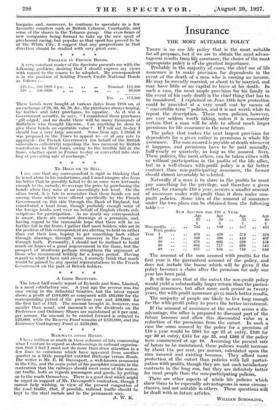Insurance
THE MOST SUITABLE POLICY THERE is no one life policy that is the most suitable for all purposes, but if we are to obtain the most advan- tageous results from life assurance, the choice of the most appropriate policy is of the greatest importance. Probably in the majority of cases, the chief use of life assurance is to make provision for dependents in the event of the death of a man who is earning an income. He may be recently married, or about to be married, and may have little or no capital to leave at his death. In such a case, the most ample provision for his family in the event of his early death is the chief thing that has to be considered. I explained on June 18th how protection could be provided at a very small cost by means of " convertible term ". policies, and it is not worth while to repeat the description. These term policies, however, are very seldom 'Worth taking, unless it is reasonably certain that a man will be able to afford much larger premiums for life assurance in the near future.
The policy that makes the next largest provision for dependents for a given outlay in premiums is whole life assurance. The sum assured is payable at death whenever it happens, and premiums have to be paid annually, half-yearly or quarterly, as long as the assured lives. These policies, like most others, can be taken either with or withOut p-irticipation in the profits of the life office, but as a well-chosen with-profit policy is a far better contract - thari non-participating assurance, the former should almost invariably be selected.
Naturally if a man is to share in the profits he must pay something for the privilege, and therefore a given outlay, for example £10 a year, secures a smaller amount of assurance under with-profit than it does under non- profit policies. Some idea of the amount of assurance under the two plans can be obtained from the following table :— SUM ASSURED FOR £10 A YEAR.
Non-profits With profits Year 1 10 • • 20 • • 30 40
- • -0
• •
• •
Age
25 .. £
705 ..
478 ..
569 676 804 957 Age 30 £ 609 426 506 603 717 853 ..
..
• • .. .. .. .. Age 35 £ 517 374 445 529 629 749 . • ..
• • • • • • • • • •
Age 40 434 324 407 458 545 649
The amount of the sum assured with profits for the first year is the guaranteed amount of the policy, and does not include the bonus which will be given if the policy becomes a claim after the premium for only one year has been paid.
It will be seen that at the outset the non-profit policy would yield a substantially larger return than the partici- pating assurance, but after some such period as twenty years, the with-profit assurance gives much better results.
The majority of people are likely to live long enough for the with-profit' policy to prove the better investment.
If the amount of assurance at the outset seems a dis- advantage, the office is prepared to discount part of the future bonuses and allow this discounted value as a reduction of the 'premiums from the outset. In such a case • the • sums assured by the policy for a premium of £10 a year would be £604 for age 25 at entry, £526 for age 30 at entry, £454 for age 35, and £386 if the policy were commenced at age 40. Assuming the present rate of bonus to .be maintained, these policies would increase by about 1 ls. per cent. per annum, calculated upon the sum assured and existing bonuses. They afford more protection at the outset than policies with full partici- pation-With-profits, though they are not such satisfactory contracts in the long run, but they are definitely better for most people than the non-participating policies.
There are other aspects of whole life policies which show them to be especially advantageous in some circum- stances, and not suitable in others. These questions will be dealt with in future articles.
WILLIAM SCHOOLING,


































 Previous page
Previous page